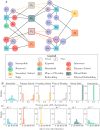Transmission dynamics of SARS-CoV-2 in a strictly-Orthodox Jewish community in the UK
- PMID: 35595824
- PMCID: PMC9121858
- DOI: 10.1038/s41598-022-12517-6
Transmission dynamics of SARS-CoV-2 in a strictly-Orthodox Jewish community in the UK
Abstract
Some social settings such as households and workplaces, have been identified as high risk for SARS-CoV-2 transmission. Identifying and quantifying the importance of these settings is critical for designing interventions. A tightly-knit religious community in the UK experienced a very large COVID-19 epidemic in 2020, reaching 64.3% seroprevalence within 10 months, and we surveyed this community both for serological status and individual-level attendance at particular settings. Using these data, and a network model of people and places represented as a stochastic graph rewriting system, we estimated the relative contribution of transmission in households, schools and religious institutions to the epidemic, and the relative risk of infection in each of these settings. All congregate settings were important for transmission, with some such as primary schools and places of worship having a higher share of transmission than others. We found that the model needed a higher general-community transmission rate for women (3.3-fold), and lower susceptibility to infection in children to recreate the observed serological data. The precise share of transmission in each place was related to assumptions about the internal structure of those places. Identification of key settings of transmission can allow public health interventions to be targeted at these locations.
© 2022. The Author(s).
Conflict of interest statement
The authors declare no competing interests.
Figures




References
-
- Lei, H., Xu, X., Xiao, S., Wu, X. & Shu, Y. Household transmission of COVID-19-a systematic review and meta-analysis. J. Infect.81(6), 979–997. ISSN 0163-4453. 10.1016/j.jinf.2020.08.033. https://www.journalofinfection.com/article/S0163-4453(20)30571-5/abstract (2020). - PMC - PubMed
-
- Rajmil, L. Role of children in the transmission of the COVID-19 pandemic: A rapid scoping review. BMJ Paediatr. Open4(1), e000722. ISSN 2399-9772. 10.1136/bmjpo-2020-000722. https://bmjpaedsopen.bmj.com/content/4/1/e000722 (2020). - PMC - PubMed
-
- Posfay-Barbe, K. M., Wagner, N., Gauthey, M., Moussaoui, D., Loevy, N., Diana, A. & L’Huillier, A. G. COVID-19 in children and the dynamics of infection in families. Pediatrics146(2), 1098–4275. ISSN 0031-4005. 10.1542/peds.2020-1576. https://pediatrics.aappublications.org/content/146/2/e20201576 (2020). - PubMed
Publication types
MeSH terms
Grants and funding
LinkOut - more resources
Full Text Sources
Medical
Miscellaneous

